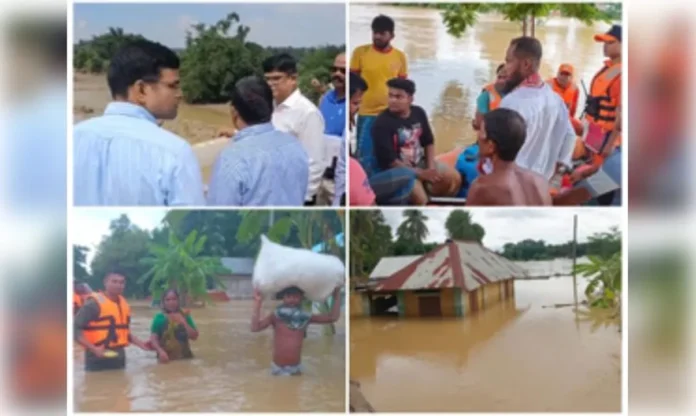The state of Tripura has been officially declared a ‘natural calamity affected area’ after recent severe weather events wreaked havoc across the region. Torrential rains, floods, and landslides have caused widespread destruction, displacing thousands of people and damaging infrastructure, homes, and agricultural land. The state government’s declaration opens the door for immediate relief and recovery efforts, with both the state and central governments mobilizing resources to help the affected populations.
The Crisis Unfolds
Tripura, a small northeastern state known for its picturesque landscapes and lush green hills, has been hit hard by the monsoon season this year. Heavy rains, starting in early June, quickly turned into a series of extreme weather events, including flash floods and landslides, which have affected several districts across the state. Rivers in the region, including the Gomati, Howrah, and Manu, swelled beyond their banks, inundating villages, towns, and agricultural fields.
The scale of destruction is extensive. Hundreds of homes have been damaged or washed away, leaving families homeless. The agricultural sector, a key part of Tripura’s economy, has also taken a significant hit, with vast areas of paddy fields and other crops being submerged under floodwaters. Roads and bridges, especially in rural and hilly areas, have been severely damaged, cutting off access to several villages. Landslides have further compounded the situation, particularly in the hilly regions, where entire slopes have given way, damaging homes and infrastructure.
As the rain persisted, the state government sounded the alarm, declaring Tripura a natural calamity affected area to ensure that relief measures could be scaled up swiftly and effectively.
Government Response and Relief Measures
Following the declaration, the Tripura government has initiated several emergency response efforts to assist those affected by the natural calamity. Relief camps have been set up in schools, community centers, and other public buildings to provide temporary shelter for displaced families. Food, drinking water, and essential supplies are being distributed to those in need, particularly in the most severely affected areas.
Chief Minister Manik Saha has been at the forefront of coordinating relief efforts. He has visited several affected regions to assess the damage and has assured the public that the state is doing everything possible to mitigate the crisis. In a public statement, Saha said, “The government is committed to providing every possible assistance to the people affected by the floods and landslides. We are working around the clock to ensure that relief reaches all those who need it.”
The state government has also requested financial and logistical assistance from the central government to bolster its efforts. In response, the central government has dispatched teams from the National Disaster Response Force (NDRF) to help with rescue and relief operations. Helicopters have been deployed to airlift stranded residents in remote areas, while boats are being used to evacuate people from flood-hit zones.
Additionally, compensation packages have been announced for families who have lost their homes or livestock, and for farmers whose crops have been destroyed. The government has also announced plans to rebuild damaged infrastructure, including roads, bridges, and irrigation systems, once the floodwaters recede.
Environmental and Economic Impact
The impact of this natural calamity extends beyond the immediate destruction of homes and infrastructure. The floods and landslides have dealt a severe blow to the state’s economy, particularly in the agricultural sector, which is the livelihood of many in rural Tripura. With large areas of farmland submerged and crops destroyed, farmers are facing significant financial losses.
Experts are concerned that the state’s food security could be impacted, as this year’s crop yield may fall short due to the devastation. The loss of livestock has further compounded the problems for rural families, many of whom rely on animal husbandry as a secondary source of income.
Environmentalists are also sounding alarms about the longer-term effects of the floods and landslides. The heavy rains have caused widespread soil erosion, particularly in hilly regions, which could lead to further landslides in the future. Additionally, deforestation and poor land management have exacerbated the situation, making the land more vulnerable to extreme weather events.
The Road to Recovery
While immediate relief efforts are underway, the road to recovery for Tripura will be long and challenging. Rebuilding homes, infrastructure, and agricultural land will take time and significant resources. The state government has pledged to work with the central government and international aid organizations to secure the necessary funds and support for long-term recovery.
Efforts will also need to focus on building resilience to future natural disasters. Given the increasing frequency of extreme weather events linked to climate change, Tripura, like many other states in the northeastern region, will need to invest in infrastructure and disaster preparedness. Improving early warning systems, strengthening river embankments, and promoting sustainable land use practices could help mitigate the impact of future calamities.
The declaration of Tripura as a ‘natural calamity affected area’ underscores the severity of the damage caused by recent floods and landslides. As the state grapples with the immediate aftermath, the focus is on providing relief and rebuilding lives. However, the long-term challenge remains to ensure that Tripura emerges stronger and more resilient in the face of future natural disasters.




